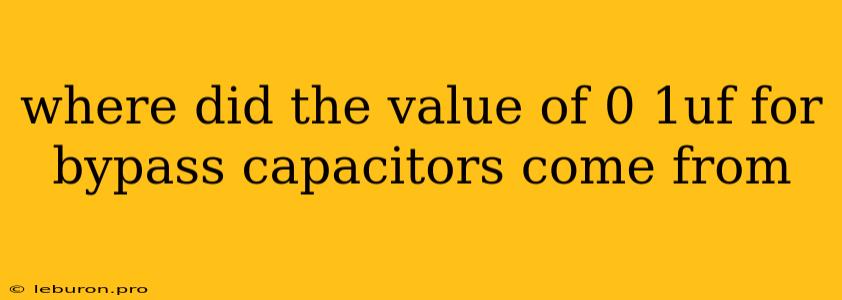The ubiquitous 0.1µF bypass capacitor, found in countless electronic circuits, is a crucial component for ensuring stable operation and preventing unwanted oscillations. While its presence is almost a given, the specific value of 0.1µF (or 100nF) might seem arbitrary. The selection of this value isn't a random choice but stems from a combination of historical, practical, and theoretical factors. This article will delve into the origins and rationale behind the widespread use of this particular capacitance value for bypass capacitors.
Understanding Bypass Capacitors
Before diving into the specific value, it's essential to understand the role of bypass capacitors in electronic circuits. Bypass capacitors, also known as decoupling capacitors, act as a "short circuit" for high-frequency signals while providing a low-impedance path to ground for unwanted noise and variations in the power supply voltage. This is achieved by their ability to store and discharge electrical energy very quickly at high frequencies.
How They Work
Imagine a power supply line feeding a complex integrated circuit (IC). The IC draws current, and as it operates, it generates high-frequency noise due to its internal switching actions. This noise can couple onto the power supply line and disrupt the smooth flow of current to other parts of the circuit.
Here's where the bypass capacitor comes in:
- High-frequency signals: As the noise signal fluctuates at high frequencies, the capacitor's reactance (resistance to alternating current) becomes very low. This allows the high-frequency noise to flow through the capacitor to ground instead of traveling along the power supply line.
- Low-impedance path: By providing a low-impedance path to ground, the capacitor effectively "shorts out" the noise before it can reach sensitive parts of the circuit.
The Significance of 0.1µF
The 0.1µF value isn't etched in stone and is often accompanied by smaller capacitors (like 0.01µF) for higher frequencies. However, 0.1µF emerges as a common value due to a confluence of factors:
1. Historical Influence:
- The development of integrated circuits (ICs) in the 1960s and 1970s coincided with the widespread availability of inexpensive ceramic capacitors. These capacitors, particularly the NPO (Negative Positive Zero) type, offered excellent stability and were ideal for bypass applications.
- The 0.1µF value was commonly available in ceramic capacitors at that time, making it a convenient choice for designers.
2. Practical Considerations:
- Frequency Range: The 0.1µF value is effective at bypassing noise frequencies typically encountered in digital circuits, which are usually in the MHz range. The capacitive reactance of a 0.1µF capacitor at 1MHz is about 1.6 ohms, providing a significant low-impedance path for noise currents.
- Size and Cost: 0.1µF capacitors are relatively small and inexpensive, making them cost-effective for widespread use in circuit boards.
3. Theoretical Rationale:
- Power Supply Decoupling: While not a strict mathematical rule, a general guideline for bypass capacitors is to ensure a capacitance value sufficient to handle the peak current demands of the IC for a given frequency.
- Impedance Matching: In some cases, the choice of 0.1µF might be influenced by the need to match the impedance of the power supply line to minimize signal reflections. This is especially important at high frequencies where reflections can cause instability.
The Importance of Proper Placement
While the 0.1µF value is a good starting point, it's crucial to remember that the effectiveness of a bypass capacitor depends heavily on its placement. The capacitor should be placed as close as physically possible to the IC's power supply pin to minimize the length of the path the noise signal has to travel before being shunted to ground. Shortening the path minimizes inductance, which can impede the capacitor's ability to effectively bypass high-frequency noise.
Conclusion
The prevalence of the 0.1µF value for bypass capacitors stems from a combination of historical development, practical considerations, and theoretical principles. While other values might be appropriate for specific applications, the 0.1µF bypass capacitor remains a valuable tool for ensuring stable and reliable operation in a wide range of electronic circuits. Understanding its origins and its role in circuit design helps engineers make informed decisions about their capacitor selection for optimal performance.
